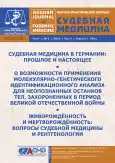О возможности определения давности повреждений на основании изменения гистоморфометрических характеристик тимуса в эксперименте
- Авторы: Халиков А.А.1, Кильдюшов Е.М.2, Кузнецов К.О.1, Комлев Д.С.3, Рахматуллина Г.Р.3
-
Учреждения:
- Башкирский государственный медицинский университет
- Российский национальный исследовательский медицинский университет имени Н.И. Пирогова
- Приволжско-Уральское бюро судебно-медицинской экспертизы
- Выпуск: Том 7, № 2 (2021)
- Страницы: 96-100
- Раздел: Экспертная практика
- URL: https://journals.rcsi.science/2411-8729/article/view/122410
- DOI: https://doi.org/10.17816/fm401
- ID: 122410
Цитировать
Полный текст
Аннотация
Актуальность. Известно, что лимфоидная ткань первой реагирует на стресс, что проявляется характерными морфологическими изменениями, на основании которых возможно изучить давность образования повреждения. Цель исследования — изучить в эксперименте динамику изменения гистоморфометрических характеристик тимуса крысы в процессе регенерации кожно-мышечной ткани при механической травме бедра. Материал и методы. Исследованы 2 группы (опыт и контроль) половозрелых крыс (n=84), которых разделили на 4 подгруппы в зависимости от времени, прошедшего с момента травмы (1; 3; 15 и 25-е сут). Механическое повреждение моделировали с помощью установки, которая передавала кинетическую энергию тканям, сопоставимую с энергией пули винтовки калибра 5,6 мм. Животных выводили из опыта путем декапитации, извлекали тимус и подвергали его микроскопическому исследованию. В условных единицах определяли общую площадь долек, площадь корковой и мозговой зоны. Результаты. Полученные нами результаты исследования свидетельствуют о фазности изменений гистоморфометрической характеристики строения тимуса, которые соответствуют фазам течения раневого процесса, что можно использовать в судебно-медицинской практике с целью определения давности травмы. Заключение. Таким образом, механическая травма, рассматриваемая как стресс-реакция, вызывает инволютивные изменения в тимусе, характеризующиеся изменением показателей площади коркового и мозгового вещества тимуса и закономерной динамикой изменения площади долек тимуса на этапах регенерации раны.
Ключевые слова
Полный текст
Открыть статью на сайте журналаОб авторах
Айрат Анварович Халиков
Башкирский государственный медицинский университет
Email: airat.expert@mail.ru
ORCID iD: 0000-0003-1045-5677
SPIN-код: 1895-7300
д.м.н., профессор
Россия, 450008, Республика Башкортостан, Уфа, ул. Ленина, д. 3Евгений Михайлович Кильдюшов
Российский национальный исследовательский медицинский университет имени Н.И. Пирогова
Email: kem1967@bk.ru
ORCID iD: 0000-0001-7571-0312
SPIN-код: 6412-0687
д.м.н., профессор
Россия, МоскваКирилл Олегович Кузнецов
Башкирский государственный медицинский университет
Автор, ответственный за переписку.
Email: kirillkuznetsov@aol.com
ORCID iD: 0000-0002-2405-1801
студент 6-го курса
Россия, 450008, Республика Башкортостан, Уфа, ул. Ленина, д. 3Дмитрий Сергеевич Комлев
Приволжско-Уральское бюро судебно-медицинской экспертизы
Email: komlevds@mail.ru
ORCID iD: 0000-0003-4180-5326
эксперт
Россия, УфаГульназ Рифовна Рахматуллина
Приволжско-Уральское бюро судебно-медицинской экспертизы
Email: rgulnaz779@gmail.ru
ORCID iD: 0000-0001-9509-5978
эксперт
Россия, УфаСписок литературы
- Еникеев Д.А., Кузнецов К.О., Еникеев О.А., и др. Патофизиологические и патохимические аспекты влияния перекиси водорода на организм человека и животных // Патогенез. 2021. Т. 19, № 1. С. 30–36. doi: 10.25557/2310-0435.2021.01.30-36
- Taves M.D., Ashwell J.D. Glucocorticoids in T cell development, differentiation and function // Nat Rev Immunol. 2021. Vol. 21, N 4. P. 233–243. doi: 10.1038/s41577-020-00464-0
- Мурзабаев Х.Х., Кашапов И.Г. Способ дозированной передачи кинетической энергии снаряда повреждаемым тканям // Морфология. 2001. Т. 120, № 6. С. 83−84.
- Kondo T. Timing of skin wounds // Legal Medicine. 2007. Vol. 9, N 2. P. 109–114. doi: 10.1016/j.legalmed.2006.11.009
- Rezzani R., Franco C., Hardeland R., Rodella L.F. Thymus-pineal gland axis: revisiting its role in human life and ageing // Int J Mol Sci. 2020. Vol. 21, N 22. P. 8806. doi: 10.3390/ijms21228806
- Miller J.F. The function of the thymus and its impact on modern medicine // Science. 2020. Vol. 369, N 6503. Р. eaba2429. doi: 10.1126/science.aba2429
- Billard M.G., Gruver A.L., Sempowski G.D. Acute endotoxin-induced thymic atrophy is characterized by intrathymic inflammatory and wound healing responses // PLos One. 2011. Vol. 6, Р. e17940. doi: 10.1371/journal.pone.0017940
- Cosway E.J., James K.D., Lucas B., et al. The thymus medulla and its control of αβT cell development // Semin Immunopathol. 2021. Vol. 43, N 1. P. 15–27. doi: 10.1007/s00281-020-00830-z
- Han J., Zúñiga-Pflücker J.C. A 2020 view of thymus stromal cells in T cell development // J Immunol. 2021. Vol. 206, N 2. P. 249–256. doi: 10.4049/jimmunol.2000889
- McBride M.A., Owen A.M., Stothers C.L., et al. The metabolic basis of immune dysfunction following sepsis and trauma // Front Immunol. 2020. Vol. 29, N 11. P. 1043. doi: 10.3389/fimmu.2020.01043
Дополнительные файлы










